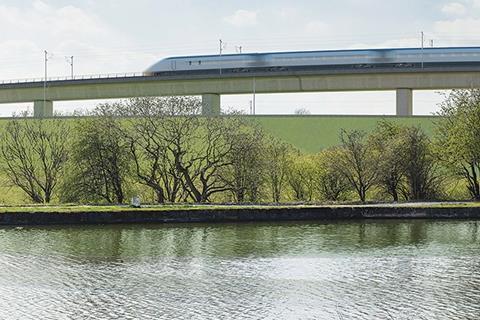Annual report from the Infrastructure and Projects Authority questions deliverability of HS2, the Lower Thames Crossing and others

Serious questions have been raised by the Infrastructure and Projects Authority over the future of four in 10 of the government’s biggest construction and infrastructure projects.
According to the IPA’s newly-released 2017-18 annual report on major projects, HS2 (pictured), the Priority School Building Programme, the Lower Thames Crossing, and the Prison Estate Transformation Programme are among the projects at risk of failing.
The IPA, formed in 2016 by the merger of Infrastructure UK and the Major Projects Authority, is claimed by ministers to “sit at the heart of government” and reports to the Treasury and the Cabinet Office.
Its latest report reveals that 12 of the 31 construction and infrastructure projects are rated red, meaning that successful delivery “appears to be unachievable”, or amber/red- where it is “in doubt.” This is three times the number in 2016-17, where none were rated red and just four were assessed as being amber/red.
The average whole life cost of construction and infrastructure projects is £6.3bn, according to the IPA, which means that projects worth a total of around £75.6bn are in doubt.
Those rated red are the Intercity Express Programme, M20 Lorry Area, and the Emergency Services Mobile Communications Programme. The M20 project was scrapped by the Department for Transport late last year and Highways England has been tasked with coming up with a new plan.
Projects rated amber/red include the Geological Disposal Facility Programme; the Priority School Building Programme 2; HS2; Lower Thames Crossing Feasibility; East West Rail; Great Western Route Modernisation; North of England Programme; South West Route Capacity, and the Prison Estate Transformation Programme.
Some 39% of construction and infrastructure projects are at serious risk of failure, compared to 16% of projects that were rated red or amber/red in 2014-15.
The report warned: “Red rated infrastructure and construction projects are facing specific technical and commercial issues as they enter challenging stages of delivery. Without mitigating action, these issues would put delivery at risk.”
Tony Meggs, IPA chief executive, said in the foreword to the report: “We are seeing specific delivery challenges on a small number of very difficult projects. This is to be expected in a large portfolio of the most high risk projects. But more can be done.
“Over the next year we will focus on improving portfolio management skills to make sure we match projects with the right resources and capabilities to deliver, and better understand and manage portfolio risk.”
The problems facing large building projects are part of a wider issue, with some 35% of all major government projects rated red or amber/red in the past year – up from 16% in 2013-14.
At the other end of the scale, the overall number of projects rated green and therefore “highly likely” to succeed has plummeted from 32 in 2013-14, representing 17% of all projects, to just two in 2017-18 – representing less than two per cent of projects.
The new figures also reveal a sharp drop in the number of new major government projects over the last 12 months. Just 18 new projects were added in 2017-18, the lowest number since the annual report’s first release in 2013 and a 50% drop from the 36 projects added in 2016-17.
Commenting on the levels of concern over current projects, a spokesperson for the IPA said: “Projects can be rated red for a variety of reasons, and often reflect the scale and complexity of large projects at early stages of delivery, or at a specific point in time should an identified challenge not be addressed.”
The spokesperson added: “By undertaking these reviews and identifying potential issues effectively and quickly, project ratings are improved, and over half of this year’s 26 completed projects received a Green or Amber Green Delivery Confidence Assessment.”



























No comments yet